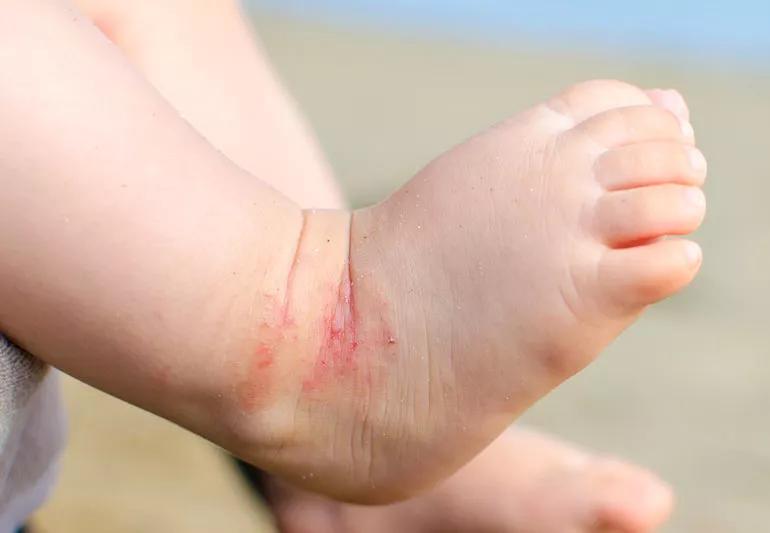Nobody wants to see their kid itching and miserable — but a lot of us do, thanks to eczema. According to pediatric dermatologist Joan Tamburro, DO, up to 30% of children under age 2 can have atopic dermatitis, more commonly known as eczema.
Eczema is an inflammation of the skin that tends to run in families. It’s most common in those with a personal or family history of asthma, hay fever or other allergies.
Most children outgrow the condition, although flare-ups (flares) can recur throughout life. And dry, sensitive skin may always be a concern. We talked to Dr. Tamburro about the best way to treat your child’s eczema flares — and what you can do to help prevent them.
Understanding your child’s eczema
What exactly is eczema, anyway?
Eczema is an inflammatory disorder of the skin. When you have eczema, your top layer of skin — the skin barrier — is weakened. That allows allergens to penetrate into your skin, causing inflammation.
“Eczema can start as dry skin, but it’s more than dryness,” says Dr. Tamburro. “It often turns into a red, extremely itchy rash that can even ooze. Sometimes, scratching can cause the rash to bleed, crust and scale over.” The resulting areas of open skin can lead to skin infections.
Eczema can appear anywhere on the body, Dr. Tamburro says, but location often changes with age. It’s usually on the:
- Face, scalp and trunk in infants.
- Arms and legs in toddlers.
- Elbows, wrists, creases of hands, knees, ankles, feet and neck in teens and adults.
While dry skin can trigger flares, so can environmental factors, including:
- Allergens, like dust, pollen and pet dander.
- Indoor air pollution.
- Food allergies.
- Skin irritants, like laundry detergents, dyes, fragrances and other chemicals.
- Clothing fabrics, sheets and furniture upholstery.
- Heat and sweat.
- Stress.
- Tobacco smoke.
Best treatments for kids with eczema
“Some parents are aggressive at treating other health problems but disregard their child’s eczema, thinking skin problems are no big deal,” notes Dr. Tamburro. “When children are itchy every day of their life, it is a big deal. Kids suffer with it.”
Itching due to eczema can prevent children from sleeping well. It’s also highly distracting, which can make it hard to concentrate on learning during school or daycare.
There are many ways to treat eczema, from prescription medications and over-the-counter medications to creams and home remedies. Here are some tried-and-true methods to treat an eczema flare:
- Use cold compresses. When eczema gets really red and itchy, it can feel like it’s on fire. Applying cool, wet, compresses — or an ice pack wrapped in a towel — can calm your kiddo’s angry rash.
- Apply petroleum jelly. While you’re in your medicine cabinet, grab that container of petroleum jelly. It’s a great option for moisturizing their skin that won’t sting — like some lotions or creams will — when their skin is extremely irritated.
- Prevent sleep scratching. Nobody has great impulse control when they’re unconscious, so it’s important to guard against sleep scratching. For infants and babies, a lightweight sleep sac may prove helpful. For older children, a good pair of cotton gloves might help.
- Practice good hand hygiene. Be sure that fingernails stay trimmed and hands clean to reduce the risk of infection. Just avoid hand sanitizers: They can make eczema worse.
- Bleach baths. It’s not what it sounds like, honest! If your kid scratches a lot, adding bleach to your bath can kill bacteria associated with skin infections. Don’t do this without talking to their doctor first, though.
If your child’s skin isn’t responding well — or if their eczema is getting worse — it’s time for a trip to their pediatrician. Depending on the cause and severity of your kiddo’s rash, their doctor may prescribe:
- Prescription topical steroids.
- Corticosteroids.
- Dupilumab injections.
- Immunosuppressant drugs like calcineurin inhibitors.
- Phototherapy (light therapy).
While these treatments help, eczema prevention is equally important.
Preventing flare-ups
In addition to avoiding triggers, good skin care is the best way to prevent the dry, itchy skin that can provoke eczema flares. Dr. Tamburro recommends parents help children with eczema:
- Bathe daily. “People used to think that bathing less was better for dry skin, but that’s no longer true,” says Dr. Tamburro. “Today, cleansers and washes are milder and don’t strip skin of hydration.” Use lukewarm (not hot) water and mild soaps or products that are “fragrance-free,” “hypoallergenic” or “for sensitive skin.”
- Slather on moisturizing cream. Do it immediately after bathing to seal in the most moisture, and then reapply moisturizer two or three times throughout the day. Moisturizing creams with ceramides reinforce the outermost layer of skin and are most effective. If the skin is very red, Dr. Tamburro recommends using plain petroleum jelly, as moisturizing creams may cause skin to burn.
- Stop the itch from intensifying. Itching begets scratching, which begets more itching, which begets more scratching, which begets… Ward off scratching before it gets out of hand with over-the-counter hydrocortisone ointment or antihistamine medication. Finding things to keep your child’s hands and brain busy also can help distract from the itch.
Do kids outgrow eczema?
While it’s not curable, eczema can be managed, says Dr. Tamburro. And many children do outgrow the condition, or at least can go longer in-between flares.
Still, people who’ve had flares, even as infants, need to protect their skin for the rest of their lives.
The good news: If you talk to your little one about what you’re doing and why, all the time and energy you put into managing your child’s eczema will help them keep their skin healthy and clear as they get older.
